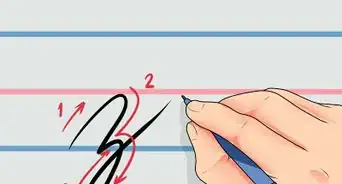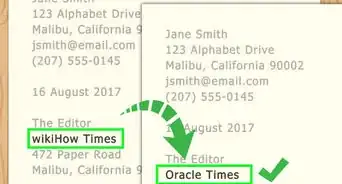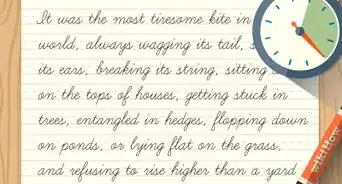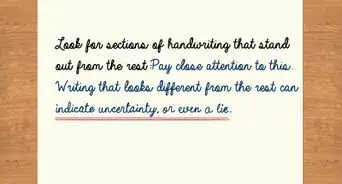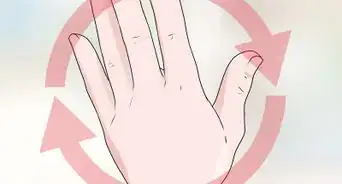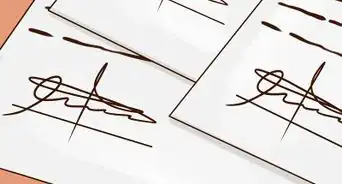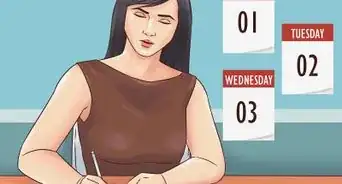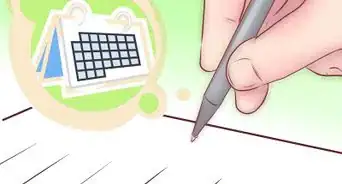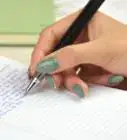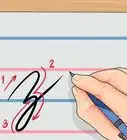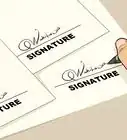This article was co-authored by wikiHow staff writer, Jennifer Mueller, JD. Jennifer Mueller is a wikiHow Content Creator. She specializes in reviewing, fact-checking, and evaluating wikiHow's content to ensure thoroughness and accuracy. Jennifer holds a JD from Indiana University Maurer School of Law in 2006.
wikiHow marks an article as reader-approved once it receives enough positive feedback. This article has 40 testimonials from our readers, earning it our reader-approved status.
This article has been viewed 1,036,352 times.
Learn more...
What can your handwriting tell you about your personality and outlook on life? Graphologists would argue it can tell you quite a bit! Even though you might've been taught to write your letters in a certain way in school, people tend to deviate from that teaching as they get older. Graphology studies how those deviations could be the expression of specific personality traits.[1] Read on to learn what characteristics to look at and what graphology tells you those characteristics mean. If you want to test it on yourself, write out a few sentences on blank, unlined paper so you can analyze as you go.
Things You Should Know
- Writing with rounded letters can be a sign you're relaxed and open-minded. Writing with rigid, pointy letters can mean you're tense.
- Dotting your i's further away from the stem could mean you're imaginative. I-dots closer to the stem can mean you're organized and methodical.
- Crossing your t's lower on the stem could be a sign of low self-esteem, while t-bars high on the stem indicates very high self-esteem.
- Using heavy pen pressure could signal you're energetic or emotional. Light pen pressure might indicate you avoid confrontation.
Steps
Community Q&A
-
QuestionI write using both print and cursive. Sometimes a word will contain both printed and cursive letters. What does that indicate?
 Community AnswerIf you just write in printed letters but connect them like cursive letters, it shows that you are an efficient person and like to save time. If it's a mix of print and cursive words, it means you're unpredictable and can be a bit antisocial.
Community AnswerIf you just write in printed letters but connect them like cursive letters, it shows that you are an efficient person and like to save time. If it's a mix of print and cursive words, it means you're unpredictable and can be a bit antisocial. -
QuestionWhile printing, the writer randomly uses capital letters in the body of the word. What does it mean?
 Community AnswerThis is most commonly seen with K, but can occur with any letter. It signifies defiance, resisting authority, and rebelliousness.
Community AnswerThis is most commonly seen with K, but can occur with any letter. It signifies defiance, resisting authority, and rebelliousness. -
QuestionWhat if the writer has several different styles of writing?
 Community AnswerIt may means that the writer is very unstable and unpredictable, especially if the writing changes from one style to another randomly.
Community AnswerIt may means that the writer is very unstable and unpredictable, especially if the writing changes from one style to another randomly.
Warnings
- This article analyzes English writing, but many of the characteristics are present in any language that uses the Latin alphabet.⧼thumbs_response⧽
- The associations in this article apply primarily to the handwriting of people who are writing in their native language.⧼thumbs_response⧽
- Graphology is not a hard science. While it might give you insight into someone's personality, avoid using it to pass judgment.⧼thumbs_response⧽
References
- ↑ https://www.britishgraphology.org/about-british-institute-of-graphologists/what-is-graphology/
- ↑ https://unfspinnaker.com/86753/features/what-your-handwriting-says-about-you-the-science-behind-handwriting/
- ↑ http://csis.pace.edu/~ctappert/srd2012/d6.pdf
- ↑ https://medcraveonline.com/FRCIJ/forensic-graphology-assessment-of-personality.html
- ↑ https://unfspinnaker.com/86753/features/what-your-handwriting-says-about-you-the-science-behind-handwriting/
- ↑ https://citeseerx.ist.psu.edu/viewdoc/download?doi=10.1.1.740.9063&rep=rep1&type=pdf
- ↑ https://media.lanecc.edu/users/mitchella/rd_wr/Handwriting%20Analysis.pdf
- ↑ http://csis.pace.edu/~ctappert/srd2012/d6.pdf
- ↑ https://citeseerx.ist.psu.edu/viewdoc/download?doi=10.1.1.740.9063&rep=rep1&type=pdf
- ↑ https://unfspinnaker.com/86753/features/what-your-handwriting-says-about-you-the-science-behind-handwriting/
- ↑ https://medcraveonline.com/FRCIJ/forensic-graphology-assessment-of-personality.html
- ↑ https://media.lanecc.edu/users/mitchella/rd_wr/Handwriting%20Analysis.pdf
- ↑ https://medcraveonline.com/FRCIJ/forensic-graphology-assessment-of-personality.html
- ↑ https://citeseerx.ist.psu.edu/viewdoc/download?doi=10.1.1.740.9063&rep=rep1&type=pdf
- ↑ https://medcraveonline.com/FRCIJ/forensic-graphology-assessment-of-personality.html
- ↑ https://media.lanecc.edu/users/mitchella/rd_wr/Handwriting%20Analysis.pdf
- ↑ https://medcraveonline.com/FRCIJ/forensic-graphology-assessment-of-personality.html
- ↑ https://medcraveonline.com/FRCIJ/forensic-graphology-assessment-of-personality.html
- ↑ https://citeseerx.ist.psu.edu/viewdoc/download?doi=10.1.1.740.9063&rep=rep1&type=pdf
- ↑ https://citeseerx.ist.psu.edu/viewdoc/download?doi=10.1.1.740.9063&rep=rep1&type=pdf
About This Article
To learn graphology, or how to analyze handwriting, look at the pressure of the stroke. High pressure means high emotional energy, average pressure means a calm but anchored person, and light pressure could mean the person is an introvert. Next, examine the slant of the strokes—a right slant shows confidence, a left slant could mean a desire to hide emotions, and no slant could mean the person tries to keep emotions in check. Also, upward writing means optimism and downward writing could mean discouragement. To learn what you can find out from the size of the letters, keep reading!
-Step-1-Version-6.webp)
-Step-2-Version-5.webp)
-Step-3-Version-4.webp)
-Step-4-Version-4.webp)
-Step-5-Version-3.webp)
-Step-6-Version-4.webp)
-Step-7-Version-3.webp)
-Step-8-Version-3.webp)
-Step-9-Version-3.webp)
-Step-10-Version-3.webp)
-Step-11-Version-3.webp)
